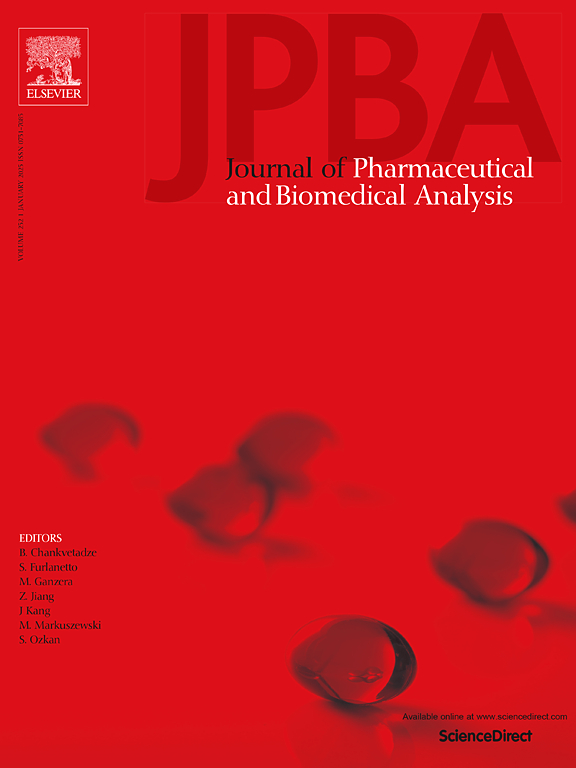Phytochemical analysis of phenolics and diterpene lactones in Andrographis paniculata plant samples and dietary supplements
IF 3.1
3区 医学
Q2 CHEMISTRY, ANALYTICAL
Journal of pharmaceutical and biomedical analysis
Pub Date : 2025-04-11
DOI:10.1016/j.jpba.2025.116866
引用次数: 0
Abstract
Andrographis paniculata, a popular immune-boosting supplement, faces quality concerns due to potential adulteration and reliance on single-marker quality assurance. To address these, a comprehensive UHPLC-PDA and LC-QToF-MS method was developed and validated to quantify and identify three classes of compounds: phenolic acids, diterpenoid lactones (including their glycosides), and flavonoid glycosides. The method achieved LOD of 10![]() 300 ng/mL and LOQ of 25
300 ng/mL and LOQ of 25![]() 1000 ng/mL for fourteen reference standards. Analysis of plant samples revealed total phenolic acids (1–4; 0.3–13 mg/g), flavonoid glycosides (6, 10, and 11; 0.2–2 mg/g), diterpene lactones (7, 13, and 14; 1.4–31 mg/g), and diterpene lactone glycosides (5, 8, 9, and 12; 0.6–17 mg/g). Furthermore, over 100 phytochemicals were tentatively identified based on characteristic mass spectral features in A. paniculata. Applying this comprehensive phytochemical profile to various supplement products revealed that over 25 % of commercial A. paniculata products failed to meet pharmacopeia standards. Detailed analysis demonstrated significant variations in the plant-part-specific distribution of diterpene lactone and its glycosides, as well as flavonoid glycosides. Some products exhibited elevated mean values for these three analyte groups, while others showed significantly lower values contributing to the observed failures. Moreover, the analytical data revealed a significant discrepancy in andrographolide (7) content, a standard quality assurance marker, between plant materials (0.4–23 mg/g) and dietary supplements (0–278 mg/serving size). Specifically, a 13 % andrographolide decrease and a corresponding increase in 14-deoxy-11,12-didehydroandrographolide (14) in A. paniculata capsules suggest processing-induced dehydration, necessitating optimized production to maintain biologically active andrographolide content. These findings underscore the necessity for rigorous quality control and comprehensive analytical methods to ensure the quality assurance of A. paniculata supplements.
1000 ng/mL for fourteen reference standards. Analysis of plant samples revealed total phenolic acids (1–4; 0.3–13 mg/g), flavonoid glycosides (6, 10, and 11; 0.2–2 mg/g), diterpene lactones (7, 13, and 14; 1.4–31 mg/g), and diterpene lactone glycosides (5, 8, 9, and 12; 0.6–17 mg/g). Furthermore, over 100 phytochemicals were tentatively identified based on characteristic mass spectral features in A. paniculata. Applying this comprehensive phytochemical profile to various supplement products revealed that over 25 % of commercial A. paniculata products failed to meet pharmacopeia standards. Detailed analysis demonstrated significant variations in the plant-part-specific distribution of diterpene lactone and its glycosides, as well as flavonoid glycosides. Some products exhibited elevated mean values for these three analyte groups, while others showed significantly lower values contributing to the observed failures. Moreover, the analytical data revealed a significant discrepancy in andrographolide (7) content, a standard quality assurance marker, between plant materials (0.4–23 mg/g) and dietary supplements (0–278 mg/serving size). Specifically, a 13 % andrographolide decrease and a corresponding increase in 14-deoxy-11,12-didehydroandrographolide (14) in A. paniculata capsules suggest processing-induced dehydration, necessitating optimized production to maintain biologically active andrographolide content. These findings underscore the necessity for rigorous quality control and comprehensive analytical methods to ensure the quality assurance of A. paniculata supplements.
穿心莲植物样品和膳食补充剂中酚类和二萜内酯的植物化学分析
穿心莲(Andrographis paniculata)是一种流行的免疫增强补充剂,由于潜在的掺假和对单一标记质量保证的依赖,面临质量问题。为了解决这些问题,开发并验证了UHPLC-PDA和LC-QToF-MS综合方法,以定量和鉴定三类化合物:酚酸、二萜内酯(包括其苷)和类黄酮苷。14种标准品的定量限为10300 ng/mL,定量限为251000 ng/mL。植物样品分析显示总酚酸(1-4;0.3-13 mg/g),类黄酮苷(6、10、11;0.2-2 mg/g),二萜内酯(7,13和14;1.4-31 mg/g),二萜内酯苷(5、8、9和12;0.6 -17 毫克/克)。此外,通过质谱特征初步鉴定出100多种植物化学物质。将这一全面的植物化学特征应用于各种补充剂产品显示,超过25% %的商业金针藤产品不符合药典标准。详细分析表明,二萜内酯及其苷类和类黄酮苷类在植物部位的分布存在显著差异。一些产品显示出这三种分析物组的平均值升高,而另一些产品显示出明显较低的值,导致观察到的失败。此外,分析数据显示,植物材料(0.4-23 mg/g)和膳食补充剂(0-278 mg/份)的穿心莲内酯(7)含量(标准质量保证标志)存在显著差异。具体来说,穿心莲胶囊中14-脱氧-11,12-二脱氢穿心莲内酯(14)减少了13. %,而相应的增加了14-脱氧-11,12-二脱氢穿心莲内酯(14),这表明加工引起的脱水,需要优化生产以保持生物活性的穿心莲内酯含量。这些发现强调了严格的质量控制和综合分析方法的必要性,以确保金针藤补充剂的质量保证。
本文章由计算机程序翻译,如有差异,请以英文原文为准。
求助全文
约1分钟内获得全文
求助全文
来源期刊
CiteScore
6.70
自引率
5.90%
发文量
588
审稿时长
37 days
期刊介绍:
This journal is an international medium directed towards the needs of academic, clinical, government and industrial analysis by publishing original research reports and critical reviews on pharmaceutical and biomedical analysis. It covers the interdisciplinary aspects of analysis in the pharmaceutical, biomedical and clinical sciences, including developments in analytical methodology, instrumentation, computation and interpretation. Submissions on novel applications focusing on drug purity and stability studies, pharmacokinetics, therapeutic monitoring, metabolic profiling; drug-related aspects of analytical biochemistry and forensic toxicology; quality assurance in the pharmaceutical industry are also welcome.
Studies from areas of well established and poorly selective methods, such as UV-VIS spectrophotometry (including derivative and multi-wavelength measurements), basic electroanalytical (potentiometric, polarographic and voltammetric) methods, fluorimetry, flow-injection analysis, etc. are accepted for publication in exceptional cases only, if a unique and substantial advantage over presently known systems is demonstrated. The same applies to the assay of simple drug formulations by any kind of methods and the determination of drugs in biological samples based merely on spiked samples. Drug purity/stability studies should contain information on the structure elucidation of the impurities/degradants.

 求助内容:
求助内容: 应助结果提醒方式:
应助结果提醒方式:


